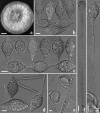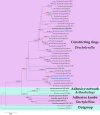Drechslerelladaliensis and D.xiaguanensis (Orbiliales, Orbiliaceae), two new nematode-trapping fungi from Yunnan, China
- PMID: 36761641
- PMCID: PMC9836436
- DOI: 10.3897/BDJ.10.e96642
Drechslerelladaliensis and D.xiaguanensis (Orbiliales, Orbiliaceae), two new nematode-trapping fungi from Yunnan, China
Abstract
Background: Nematode-trapping fungi are a highly specialised group in fungi and are essential regulators of natural nematode populations. At present, more than 130 species have been discovered in Zygomycota (Zoopagaceae), Basidiomycota (Nematoctonus), and Ascomycota (Orbiliaceae). Amongst them, nematode-trapping fungi in Orbiliaceae have become the research focus of carnivorous fungi due to their abundant species. During the investigation of carnivorous fungi in Yunnan, China, four fungal strains isolated from burned forest soil were identified as two new nematode-trapping species in Drechslerella (Orbiliaceae), based on multigene phylogenetic analysis and morphological characters.
New information: Drechslerelladaliensis sp. nov. is characterised by its ellipsoid, 1-2-septate macroconidia, clavate or bottle-shaped, 0-1-septate microconidia and unbranched, simple conidiophores. D.xiaguanensis sp. nov. is characterised by fusiform or spindle-shaped, 2-4-septate conidia and unbranched, simple conidiophores. Both of them produce constricting rings to capture nematodes. The phylogenetic analysis, based on combined ITS, TEF1-α and RPB2 sequences, determined their placement in Drechslerella. D.daliensis forms a basal lineage closely nested with D.hainanensis (YMF1.03993). D.xiaguanensis forms a sister lineage with D.bembicodes (1.01429), D.aphrobrocha (YMF1.00119) and D.coelobrocha (FWY03-25-1).
Keywords: Orbiliaceae; carnivorous fungi; constricting rings; new species; taxonomy.
Fa Zhang, Saranyaphat Boonmee, Jutamart Monkai, Xiao-Yan Yang, Wen Xiao.
Figures



Similar articles
-
Morphological and Phylogenetic Characterization of Five Novel Nematode-Trapping Fungi (Orbiliomycetes) from Yunnan, China.J Fungi (Basel). 2023 Jul 7;9(7):735. doi: 10.3390/jof9070735. J Fungi (Basel). 2023. PMID: 37504724 Free PMC article.
-
Two new species of nematode-trapping fungi: relationships inferred from morphology, rDNA and protein gene sequence analyses.Mycol Res. 2006 Jul;110(Pt 7):790-800. doi: 10.1016/j.mycres.2006.04.011. Mycol Res. 2006. PMID: 16876699
-
Arthrobotrys blastospora sp. nov. (Orbiliomycetes): A Living Fossil Displaying Morphological Traits of Mesozoic Carnivorous Fungi.J Fungi (Basel). 2023 Apr 6;9(4):451. doi: 10.3390/jof9040451. J Fungi (Basel). 2023. PMID: 37108905 Free PMC article.
-
Nematode-Trapping Fungi.Microbiol Spectr. 2017 Jan;5(1):10.1128/microbiolspec.funk-0022-2016. doi: 10.1128/microbiolspec.FUNK-0022-2016. Microbiol Spectr. 2017. PMID: 28128072 Free PMC article. Review.
-
Predator-prey interactions of nematode-trapping fungi and nematodes: both sides of the coin.Appl Microbiol Biotechnol. 2018 May;102(9):3939-3949. doi: 10.1007/s00253-018-8897-5. Epub 2018 Mar 9. Appl Microbiol Biotechnol. 2018. PMID: 29523933 Review.
Cited by
-
Conidia Fusion: A Mechanism for Fungal Adaptation to Nutrient-Poor Habitats.J Fungi (Basel). 2023 Jul 17;9(7):755. doi: 10.3390/jof9070755. J Fungi (Basel). 2023. PMID: 37504743 Free PMC article.
-
Proteomic insights into nematode-trapping fungi Arthrobotrys oligospora after their response to chitin.J Vet Res. 2025 Feb 25;69(1):71-82. doi: 10.2478/jvetres-2025-0005. eCollection 2025 Mar. J Vet Res. 2025. PMID: 40144063 Free PMC article.
-
Exploring ascomycete diversity in Yunnan II: Introducing three novel species in the suborder Massarineae (Dothideomycetes, Pleosporales) from fern and grasses.MycoKeys. 2024 Apr 16;104:9-50. doi: 10.3897/mycokeys.104.112149. eCollection 2024. MycoKeys. 2024. PMID: 38665970 Free PMC article.
-
Morphological and Phylogenetic Characterization of Five Novel Nematode-Trapping Fungi (Orbiliomycetes) from Yunnan, China.J Fungi (Basel). 2023 Jul 7;9(7):735. doi: 10.3390/jof9070735. J Fungi (Basel). 2023. PMID: 37504724 Free PMC article.
References
-
- Barron GL. The nematode-destroying fungi. Canadian Biological Publications Ltd; Guelph: 1977. 45
-
- Burges A, Raw F. Soil Biology. Academic Press; London: 1967.
-
- Cooke R. C. The ecology of nematode‐trapping fungi in the soil. Annals of Applied Biology. 1962;50(3):507–513. doi: 10.1111/j.1744-7348.1962.tb06045.x. - DOI
-
- Drechsler C. Several species of Dactylellina and Dactylaria that capture free-living nematode. Mycologia. 1950;42:1–79. doi: 10.1080/00275514.1950.12017816. - DOI
LinkOut - more resources
Full Text Sources
